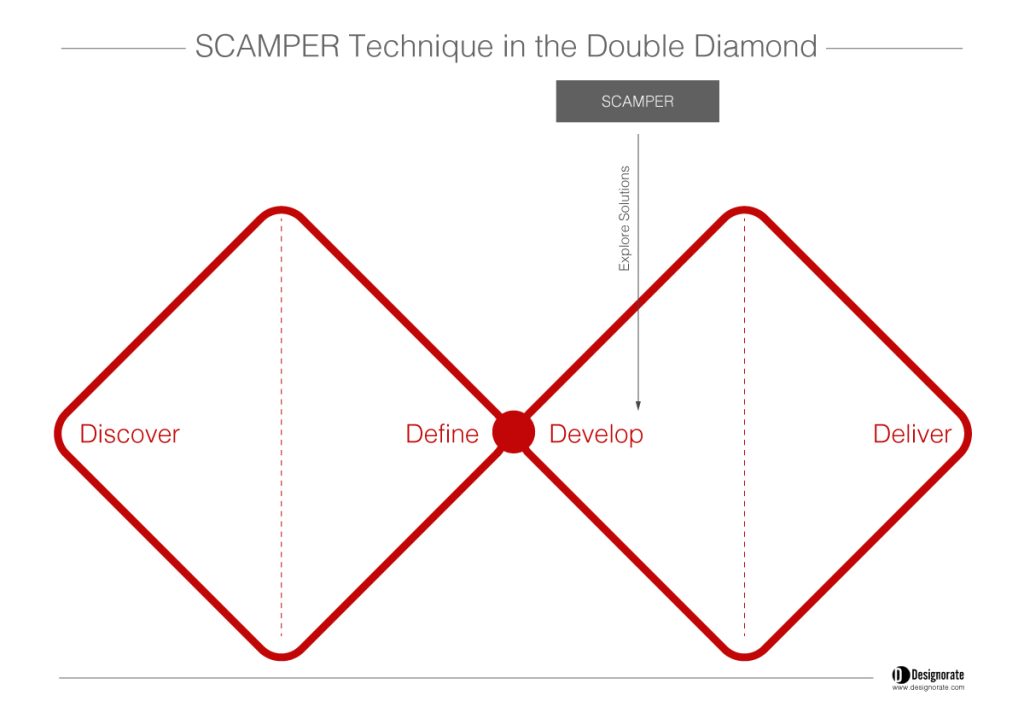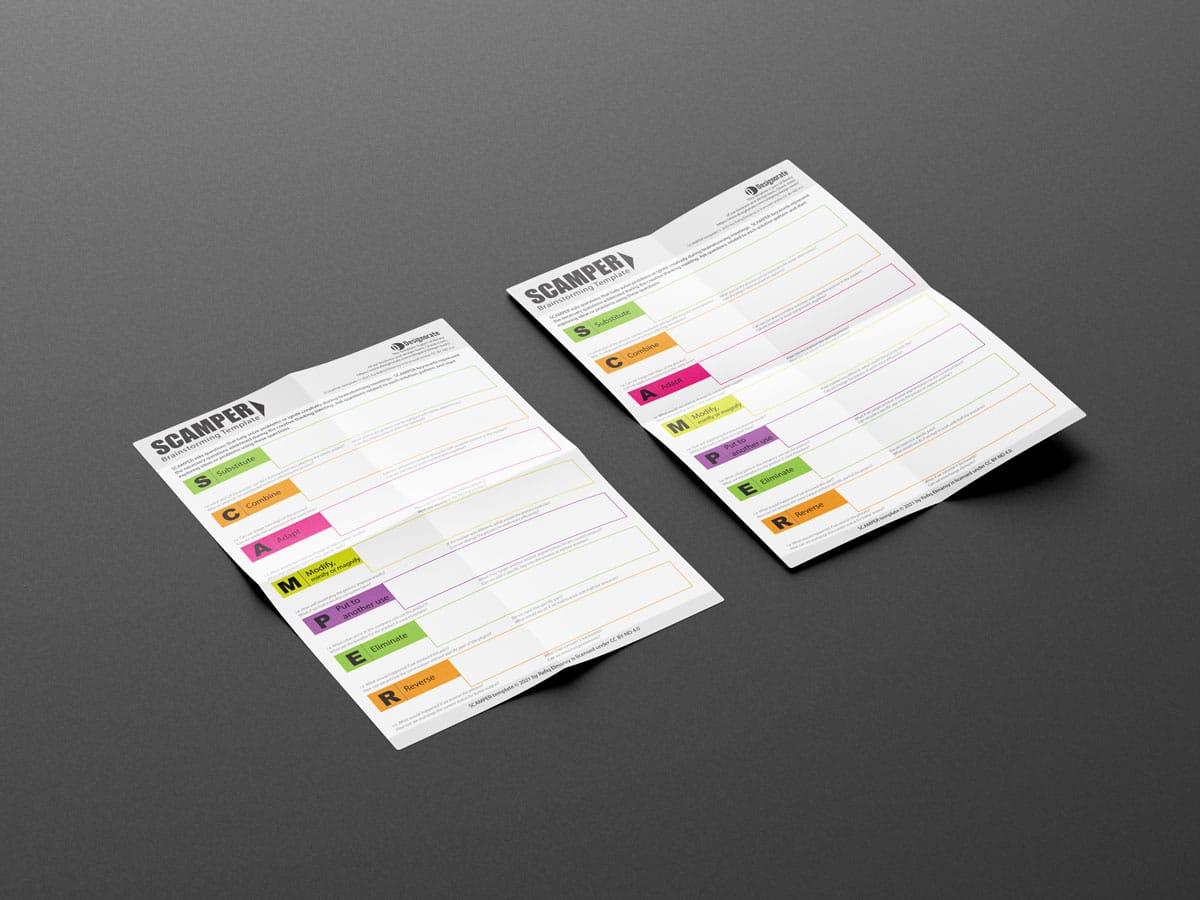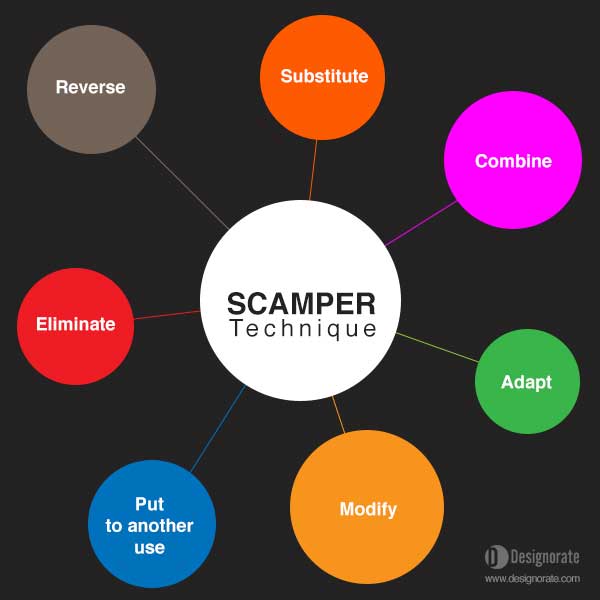A Guide to the SCAMPER Technique for Design Thinking
Creative thinking and problem-solving are essential parts of the design thinking process to turn ideas into innovation and break the barriers against creativity. One of the successful methods used in creative thinking is the SCAMPER technique. While there are different creative thinking and problem-solving techniques, such as reversed brainstorming, Hurson’s thinking model, the six thinking hats and Lego Serious Play, SCAMPER is considered one of the easiest and most direct methods. The SCAMPER technique is based very simply on the idea that what is new is actually a modification of existing old things around us. As Ambrose Bierce said: “There is nothing new under the sun, but there are lots of old things we don’t know.” although I do not fully agree with him.
At the end of the article, you will find the link to download the Designorate Free SCAMPER template, which allows you to collaborate with your team and use the tool in the co-design practice.
What is the SCAMPER technique? And How Does It Work?
SCAMPER was first introduced by Bob Eberle to address targeted questions that help solve problems or ignite creativity during brainstorming meetings. The name SCAMPER is acronym for seven techniques; (S) substitute, (C) combine, (A) adapt, (M) modify, (P) put to another use, (E) eliminate and (R) reverse. These keywords represent the necessary questions addressed during the creative thinking meeting.
There are two main concepts to remember before starting the brainstorming using the SCAMPER technique, yet there is no sequential flow to follow while moving from each of the seven thinking techniques. Unlike Disney’s creative strategy method, SCAMPER facilitators can move between different techniques without being restricted to a specific flow. Secondly, the principle of force-fitting should be adapted during the thinking sessions. For example, any response to the SCAMPER technique is welcomed, no matter how non-logical it is.
Figure 1. The SCAMPER Technique.
Using the SCAMPER Technique in Design Thinking
In the Double Diamond Design Thinking, we go through four stages: Discover, Define, Develop, and Deliver. The SCAMPER technique fits in the third stage, Develop (Figure 2). Once we define the problem that we need to solve in the second stage, we can use the seven ways of thinking to try to investigate the different solutions. The idea is that we usually tend to use existing mental models or existing solutions passway that prevent us from seeing other innovative directions. By changing how we see problems using the SCAMPER or other methods, such as Reversed Brainstorming, we stimulate our neuron connections to build new connections that lead to new solutions. In my article, Why Design Thinking Doesn’t Work, I tried to address the nature of the design thinking process and clarify many of the misconceptions about it in recent years.
In other design thinking models, such as IDEO or IBM design thinking, the method can be applied in a similar phase when we define the problem and enter the prototyping stage of the design process.

The Seven Dimensions of the SCAMPER Technique
After exploring the main concept of the technique, let’s see how each of these dimensions works and can be applied in practice. You can also check SCAMPER Technique Examples and Applications for real-life case studies showing how the method is used in different companies.
Substitute
The substitute technique focuses on the parts of the product, service, or solution that can be replaced with another. During this part of the discussion, the meeting attendees focus on making decisions to substitute one part of the process with another. Questions asked during this part are:
- What part of the process can be substituted without affecting the whole project?
- Who or what can be substituted without affecting the process?
- What part of the process can be replaced with better alternatives?
- Can the project time or place be replaced?
- What will happen when we replace part of the project with another?
- Where else could you sell the product?
- Could we use another alternative of X?
- Can we substitute the current device for a better one?
- Can we replace the process with a simpler one?
The substitute technique tends to provide alternative solutions for decision makers to evaluate before taking the final action.
Combine
The combined technique tends to analyze the possibility of merging two ideas, stages of the process or product into one single, more efficient output. In some cases, combining two innovative ideas can lead to a new product or technology to increase market strength. For example, merging phone technology with digital cameras produced a new revolutionary product in the telecommunications industry. The combine technique discussion can include the following questions:
- Can we merge two steps of the process?
- Can we apply two processes at the same time?
- Can our company combine resources with another partner in the market?
- Can we mix two or more components together?
- Can we combine X and Y technologies?
Adapt
Adapt refers to a brainstorming discussion that aims to adjust or tweak a product or service for a better output. This adjustment can range from minor changes to radical changes in the whole project. Adaptation is one of the most efficient techniques for solving problems by enhancing the existing system. The adapt technique brainstorming session can include the following questions:
- What would we need to change to reach better results?
- What else could be done in this specific task?
- How can we improve the existing process?
- How can we adjust the existing product?
- How can we make the process more flexible?
Modify, minify or magnify
The modified technique refers to changing the process in a way that unleashes more innovative capabilities or solves problems. This change is more than just an adjustment as it focuses on the overall process. For example, it can target reducing the project’s process or change our perspective of how to look at the problem. The questions asked under this rubric include:
- How will modifying the process improve results?
- What if we had a double consumer base?
- If the market was different, what would the process look like?
- Can we change the process so that it works more efficiently?
- What if the product is double the current size?
Put to another use
This technique concerns how to put the current product or process for another purpose or how to use the existing product to solve problems. For example, this technique can be used to learn how to shift an existing product to another market segment or user type. The questions in this technique can include the following:
- What other parts of the company can use the product?
- What are the benefits of the product if used elsewhere?
- What if we target another market segmentation for the current product?
- Can we add a specific step into the process to replace another?
- What are other ways can we use it?
- Can we recycle the waste for another use?
Eliminate or elaborate
As the name implies, this technique aims to identify the parts of the process that can be eliminated to improve the process product or service. It also helps to explore the unnecessary parts of the project. Questions related to this part include:
- What would happen if we removed this part?
- How can we achieve the same output without a specific part of the project?
- Do we need this specific part?
- What would we do if we had to work with half the resources?
In some situations, unnecessary resources or steps in the process add an extra load to the project’s ability to achieve innovation and creativity. Eliminating these resources extends the ability to innovate and allocates more resources for creativity within organizations.
Reverse
Finally, the reverse or rearrange technique aims to explore the innovative potential when changing the order of the process in the production line. Reversing the process or part of it can help solve problems or produce more innovative output. The questions in this part include:
- What would happen if we reversed the process?
- How can we rearrange the current status for better output?
- What if we consider it backwards?
- Can we interchange elements?
A good example of this dimension is the return to paper packaging to solve the plastic waste problem. Early in the 20th century, plastic was used as a cheap, reliable packaging material that overcame the paper packaging problem. However, the mass use of plastic packaging had a negative impact on the environment, humans, and living animals. Therefore, we reversed our mindset and returned to paper packaging as a solution to reduce plastic usage.
Download the Free SCAMPER Technique Template
I utilised this method in my classes with several students who successfully used the tool and found it inspiring in design and engineering projects over the last few years. So, I created this template to allow collaborative teams to work together and collect ideas using an interactive PDF. Feel free to use the template below in both commercial and non-commercial projects referring to the source. If you have any questions about using it, feel free to reach me.

Free SCAMPER
Technique
Template
Conclusion
The SCAMPER technique is one of the effective methods to identify the different solutions for problems without being restricted to a specific direction through exploring solutions from seven different dimensions (S) substitute, (C) combine, (A) adapt, (M) modify, (P) put to another use, (E) eliminate, and (R) reverse. The approach that makes it suitable to utilise in the Develop stage of the Double Diamond design thinking is to explore the different solution prototypes. If you applied the method before or explored it, I would be glad to hear your opinions and feedback about applying it from your perspective.
Bibliography
Eberle, R.F., 1972. Developing imagination through scamper. Journal of Creative Behavior.
Lopes, R., Malta, P., Mamede, H. and Santos, V., 2020. A Creative Information System Based on the SCAMPER Technique. In Information Systems: 17th European, Mediterranean, and Middle Eastern Conference, EMCIS 2020, Dubai, United Arab Emirates, November 25–26, 2020, Proceedings 17 (pp. 595-606). Springer International Publishing.
Serrat, O. and Serrat, O., 2017. The SCAMPER technique. Knowledge solutions: tools, methods, and approaches to drive organizational performance, pp.311-314.








Hello sir,
I am a teacher in an IB school, I would like to invite you in our school to inspire our students with your knowledge. I hope you don`t mind and accept our invitation.
Thanks in advance.
Best Regards,
Mrs Haydy.
Hi Haydy, I’m sorry for the delay reply. I used to have lots of spam through comments which makes some hard to find. The best way to get in touch is through email [email protected]
Please consider changing the word “adaption” to “adaptation”. Adaption is not a word.
Thanks for the correction, just fixed.